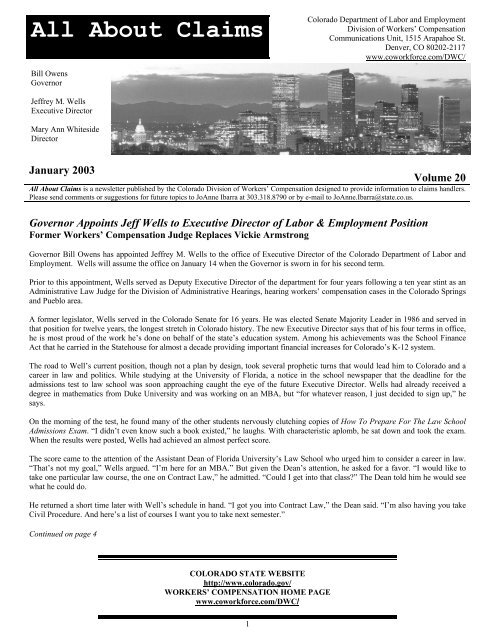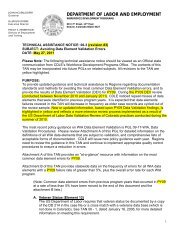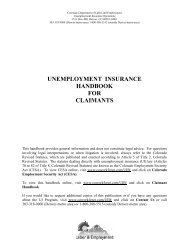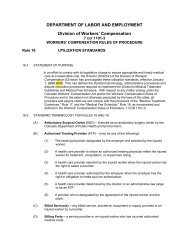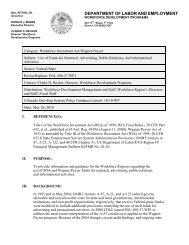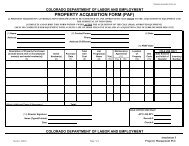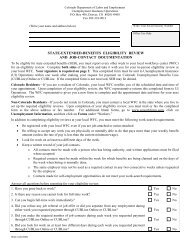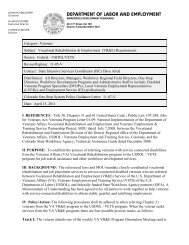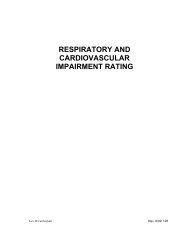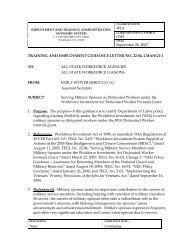Volume 20 - Colorado Department of Labor and Employment
Volume 20 - Colorado Department of Labor and Employment
Volume 20 - Colorado Department of Labor and Employment
Create successful ePaper yourself
Turn your PDF publications into a flip-book with our unique Google optimized e-Paper software.
All About Claims<strong>Colorado</strong> <strong>Department</strong> <strong>of</strong> <strong>Labor</strong> <strong>and</strong> <strong>Employment</strong>Division <strong>of</strong> Workers’ CompensationCommunications Unit, 1515 Arapahoe St.Denver, CO 80<strong>20</strong>2-2117www.coworkforce.com/DWC/Bill OwensGovernorJeffrey M. WellsExecutive DirectorMary Ann WhitesideDirectorJanuary <strong>20</strong>03<strong>Volume</strong> <strong>20</strong>All About Claims is a newsletter published by the <strong>Colorado</strong> Division <strong>of</strong> Workers’ Compensation designed to provide information to claims h<strong>and</strong>lers.Please send comments or suggestions for future topics to JoAnne Ibarra at 303.318.8790 or by e-mail to JoAnne.Ibarra@state.co.us.Governor Appoints Jeff Wells to Executive Director <strong>of</strong> <strong>Labor</strong> & <strong>Employment</strong> PositionFormer Workers’ Compensation Judge Replaces Vickie ArmstrongGovernor Bill Owens has appointed Jeffrey M. Wells to the <strong>of</strong>fice <strong>of</strong> Executive Director <strong>of</strong> the <strong>Colorado</strong> <strong>Department</strong> <strong>of</strong> <strong>Labor</strong> <strong>and</strong><strong>Employment</strong>. Wells will assume the <strong>of</strong>fice on January 14 when the Governor is sworn in for his second term.Prior to this appointment, Wells served as Deputy Executive Director <strong>of</strong> the department for four years following a ten year stint as anAdministrative Law Judge for the Division <strong>of</strong> Administrative Hearings, hearing workers’ compensation cases in the <strong>Colorado</strong> Springs<strong>and</strong> Pueblo area.A former legislator, Wells served in the <strong>Colorado</strong> Senate for 16 years. He was elected Senate Majority Leader in 1986 <strong>and</strong> served inthat position for twelve years, the longest stretch in <strong>Colorado</strong> history. The new Executive Director says that <strong>of</strong> his four terms in <strong>of</strong>fice,he is most proud <strong>of</strong> the work he’s done on behalf <strong>of</strong> the state’s education system. Among his achievements was the School FinanceAct that he carried in the Statehouse for almost a decade providing important financial increases for <strong>Colorado</strong>’s K-12 system.The road to Well’s current position, though not a plan by design, took several prophetic turns that would lead him to <strong>Colorado</strong> <strong>and</strong> acareer in law <strong>and</strong> politics. While studying at the University <strong>of</strong> Florida, a notice in the school newspaper that the deadline for theadmissions test to law school was soon approaching caught the eye <strong>of</strong> the future Executive Director. Wells had already received adegree in mathematics from Duke University <strong>and</strong> was working on an MBA, but “for whatever reason, I just decided to sign up,” hesays.On the morning <strong>of</strong> the test, he found many <strong>of</strong> the other students nervously clutching copies <strong>of</strong> How To Prepare For The Law SchoolAdmissions Exam. “I didn’t even know such a book existed,” he laughs. With characteristic aplomb, he sat down <strong>and</strong> took the exam.When the results were posted, Wells had achieved an almost perfect score.The score came to the attention <strong>of</strong> the Assistant Dean <strong>of</strong> Florida University’s Law School who urged him to consider a career in law.“That’s not my goal,” Wells argued. “I’m here for an MBA.” But given the Dean’s attention, he asked for a favor. “I would like totake one particular law course, the one on Contract Law,” he admitted. “Could I get into that class?” The Dean told him he would seewhat he could do.He returned a short time later with Well’s schedule in h<strong>and</strong>. “I got you into Contract Law,” the Dean said. “I’m also having you takeCivil Procedure. And here’s a list <strong>of</strong> courses I want you to take next semester.”Continued on page 4COLORADO STATE WEBSITE http://www.colorado.gov/WORKERS’ COMPENSATION HOME PAGE www.coworkforce.com/DWC/1
Use <strong>of</strong> Nurse Practitioners <strong>and</strong> PhysiciansAssistantsBy Mary Ann Whiteside, DirectorIn an effort to provide guidance on the practical applications <strong>of</strong>the <strong>Colorado</strong> Workers’ Compensation Act, we are publishingDirector's interpretations <strong>of</strong> statutes <strong>and</strong> other factors affectingthe system, in the form <strong>of</strong> Interpretive Bulletins. The purpose isto provide greater levels <strong>of</strong> consistency <strong>and</strong> predictability as tohow the <strong>Colorado</strong> system is intended to operate. While theopinions do not have the force <strong>and</strong> effect <strong>of</strong> rule, they are <strong>of</strong>feredas navigational tools to clarify <strong>and</strong> simplify processes, createefficiencies, <strong>and</strong> to reduce litigation.If you have questions regarding this information or issues youwould like to see addressed in future bulletins, please direct yourinquiries to Mary Ann Whiteside, Director <strong>of</strong> the Division <strong>of</strong>Workers’ Compensation, at 1515 Arapahoe St. Tower II, 4thfloor, Denver, CO 80<strong>20</strong>2, FAX 303.318.8049, or email atMaryAnn.Whiteside@state.co.us.This interpretative bulletin addresses the utilization <strong>of</strong> nursepractitioners <strong>and</strong> physician assistants in <strong>Colorado</strong> workers’compensation cases. Disputes concerning the utilization <strong>of</strong> nursepractitioners <strong>and</strong> physician assistants will necessarily have to bereviewed on a case-by-case basis <strong>and</strong> in many instances, findings<strong>of</strong> fact may have to be made to resolve these disputes. Thisinterpretive bulletin is intended to provide general guidance onthe use <strong>of</strong> nurse practitioners <strong>and</strong> physician assistants todetermine specific medical issues that arise in workers’compensation cases in <strong>Colorado</strong>.The <strong>Colorado</strong> Workers’ Compensation Act (“Act”) <strong>and</strong> theWorkers’ Compensation Rules <strong>of</strong> Procedure provide as follows:C.R.S. § 8-42-105(2)(b) requires a statement fromthe attending physician regarding the employee’sinability to work resulting from a work injury ordisease;C.R.S. § 8-42-105(3) requires a statement from theattending physician regarding the employee’s abilityto return to regular or modified employment;C.R.S. § 8-42-107(8) requires that the authorizedtreating physician determine when the employeereaches maximum medical improvement, whetherthe employee has sustained permanent medicalimpairment, <strong>and</strong> if Level II accredited, the degree <strong>of</strong>permanent medical impairment.Rule IX.C.1.d. permits the termination <strong>of</strong> temporarytotal disability benefits in certain specific situationsbased on a statement from the authorized treatingphysician that the claimant has reached MMI; or isable to return to regular employment; or that theemployment <strong>of</strong>fered is within the claimant’s physicalrestrictions.Physician assistants are <strong>of</strong>ten utilized in physicians’ <strong>of</strong>fices toperform some <strong>of</strong> these functions under the supervision <strong>of</strong> theauthorized treating physician. § 12-36-106(5), C.R.S., allows2 physician assistants to work under the supervision <strong>of</strong> a licensedphysician. The question is, which functions may a physici<strong>and</strong>elegate to the physician assistant <strong>and</strong> still be in compliance withthe statutory requirements <strong>of</strong> the Workers’ Compensation Act?The case law in this specific area contains a very limiteddiscussion <strong>of</strong> the issues. For example, the Industrial ClaimAppeals Office has determined that in a release to return to worksituation, “medical restrictions imposed by a physician’s assistantmay be considered to be medical restrictions imposed by thetreating physician”. Terry v. Captain D’s Seafood Restaurant,W.C. No. 4-226-464, (ICAO, December 9, 1997). See alsoBassett v. Echo Canyon Rafting Expeditions, W.C. No. 4-260-804, (ICAO, April 3, 1997). The testimony <strong>of</strong> a physicianassistant, who had examined the claimant <strong>and</strong> determined thatshe was not injured or incapacitated, was accepted in a workers’compensation proceeding. Simms v. ICAO, 797 P. 2d 777 (Colo.App. 1990).Based on the limited discussion available, it appears that aphysician’s assistant may impose medical restrictions forpurposes <strong>of</strong> return to work <strong>and</strong> may <strong>of</strong>fer an opinion as to theclaimant’s medical condition. It is the Director’s position thatalthough a physician assistant may be utilized in these instances,the authorized treating physician remains responsible for thesupervision <strong>of</strong> any physician assistant performing any <strong>of</strong> thesefunctions <strong>and</strong> for the reporting required under the Workers’Compensation Act. The identity <strong>of</strong> the authorized treatingphysician or physicians must be clear to all parties at all stages <strong>of</strong>the proceedings. Accordingly, the Director suggests that it wouldbe advisable for the physician to counter sign any Physician’sReport <strong>of</strong> Workers’ Compensation Injury (Form WC164),opinions regarding return to work or any other reports relating tobenefits issued by a physician’s assistant.Nurse practitioners also may be utilized by physicians to performsome <strong>of</strong> the functions required under the Workers’ CompensationAct. This utilization <strong>of</strong> the nurse practitioner raises questionsregarding the delegation <strong>of</strong> these functions <strong>and</strong> the physician’scompliance with the statutory requirements <strong>of</strong> the Workers’Compensation Act. Pursuant to § 12-38-111.5, C.R.S., a nursepractitioner may be included in the advance practice registry. Anadvanced practice nurse may be granted prescriptive authoritywhile working under a collaborative agreement with a licensedphysician. Although only a limited discussion is available, nursepractitioners’ opinions in workers’ compensation have not beengenerally accepted as those <strong>of</strong> the authorized treating physician.The Industrial Claim Appeals Panel did not reach the question <strong>of</strong>whether a nurse practitioner’s opinion concerning medicalrestrictions is a sufficient basis for granting or denying disabilitybenefits in Lester v. Skill Staff <strong>of</strong> <strong>Colorado</strong>, W.C. No. 4-225-745(ICAO, August 31, 1995). However, the Panel determined in asubsequent decision that a restricted duty <strong>of</strong>fer approved by anurse practitioner rather than the authorized treating physician, asrequired by Rule IX.C.1.d., was not a reasonable basis for therespondents to believe they were entitled to terminate temporarydisability benefits in accordance with the rule. Brown v.Manfredi Motor Transit, (ICAO, September 21, <strong>20</strong>01).Based upon the case decisions on the topic, it appears that theappellate courts draw a distinction under the <strong>Colorado</strong> Workers’Compensation Act between the scope <strong>of</strong> authority <strong>of</strong> physicianassistants <strong>and</strong> nurse practitioners. Accordingly, the Directorsuggests that it would be advisable for the physician to counter
sign any Physician’s Report <strong>of</strong> Workers’ Compensation Injury(Form WC164), opinions regarding return to work or any otherreports relating to benefits issued by a nurse practitioner.The statutes <strong>and</strong> rules <strong>of</strong> procedure that govern workers’ compensationrequire that the determinations <strong>of</strong> maximum medical improvement <strong>and</strong>permanent medical impairment, including a finding that there is nomedical impairment, must be rendered by the authorized treating physician, or in some instances, a Level II accredited physician. While aphysician may utilize physician assistants <strong>and</strong> nurse practitioners fordetermining medical restrictions for return to work purposes <strong>and</strong>opinions as to medical condition, the ultimate responsibility for thesedecisions remains with the physician.Reviewing Accomplishments for the Past YearThe state deficit reminds us that more than ever, we mustvalidate our existence as a public entity through the provision <strong>of</strong>vital services. In doing so, we reflect on the accomplishmentsfor the Division <strong>of</strong> Workers’ Compensation (DOWC) for theyear <strong>20</strong>02:The DOWC has helped thous<strong>and</strong>s <strong>of</strong> <strong>Colorado</strong>employers, large <strong>and</strong> small, save millions <strong>of</strong> dollarsevery year through free risk management programs <strong>and</strong>services—$13 million saved last year, <strong>and</strong> over $100million this past decade. These programs <strong>and</strong> servicesare expected to continue to prevent millions in accidentcosts as well as the pain <strong>and</strong> suffering associated withworkplace injuries. The programs <strong>and</strong> services havepromoted greater cost savings for <strong>Colorado</strong> insurers aswell—translating into reduced system costs for all <strong>of</strong> thestate’s businesses <strong>and</strong> industries.The DOWC’s oversight <strong>of</strong> insurance claimsmanagement activity has detected payment mistakestotaling millions <strong>of</strong> dollars. Over $2.5 million inunderpayments to the state’s injured workers, <strong>and</strong> over aquarter <strong>of</strong> a million dollars <strong>of</strong> overpayments made byinsurers were identified last year alone. It’s anticipatedthat the DOWC will continue to detect over $2.5 millionin incorrect payments next year as well. Proactiveservices by Division staff to educate insurance claimsmangers are expected to reduce the occurrence <strong>of</strong>overpayments <strong>and</strong> underpayments—with real savingsexpected for all system stakeholders.Through the application <strong>of</strong> the Medical Fee Schedule,promulgated in rule by DOWC, medical bills werereduced by over $48 million last year. DOWC stafffurther contribute to medical cost savings by providingexpert assistance with billing inquiries; <strong>and</strong> updatingmedical treatment guidelines, <strong>and</strong> utilization st<strong>and</strong>ards.DOWC efforts to resolve disputes between partiesrelated to claims have resulted in thous<strong>and</strong>s <strong>of</strong>settlements each year, thus reducing further litigation.Over 3,500 pre-hearing <strong>and</strong> settlement conferences wereheld last year alone. This reduction in litigation reducessystem costs for stakeholders.3 On over 75,000 occasions, DOWC staff respondeddirectly to inquiries to the Division’s customer serviceunit last year. Another 355,000 contacts were made tothe Division’s website. The dem<strong>and</strong> for informationservices from the division is expected to growsignificantly.DOWC staff identify thous<strong>and</strong>s <strong>of</strong> employers annuallywho appear to be operating with no workers’compensation insurance. Last year, over 18,500 contactswere made to investigate employers’ insured status.Only two percent (374) <strong>of</strong> these initial contacts remainunresolved. This ongoing effort ensures that instances <strong>of</strong>injuries to workers’ without insurance coverage areminimized, which in turn reduces the socialization <strong>of</strong>these costs across the rest <strong>of</strong> the workers’ compensationsystem.Two programs administered by DOWC to providemedical care <strong>and</strong>/or compensation payments to some <strong>of</strong>the most seriously injured workers in <strong>Colorado</strong>, theMajor Medical Fund <strong>and</strong> the Subsequent Injury Fund,realized substantial savings through settlement <strong>of</strong>existing cases. Over $3.8 million were saved over thepast two years alone.Through effective oversight <strong>and</strong> support, the DOWChas continued to promote the success <strong>of</strong> <strong>Colorado</strong>’sworkers’ compensation self-insured employers. Despiteuncertain economic conditions, <strong>and</strong> an adverse riskfinancing market, <strong>Colorado</strong>’s self-insured employerslast year realized a cash flow advantage <strong>of</strong> $117 millioncumulatively as a result <strong>of</strong> self-insured derived savings.Continued management <strong>of</strong> employer self-insuranceactivity by DOWC staff is essential to the success <strong>of</strong> theconcept in our state.Division Receives Public Information Award forAnnual ReportThe International Association <strong>of</strong> Industrial Accident Boards <strong>and</strong>Commissions (IAIABC) has selected the Work Related Injuriesin <strong>Colorado</strong>, 1999, as the first place award winner in theinformation products category for <strong>20</strong>02.The publication, generally referred to as the annual report, is thework <strong>of</strong> the Research & Statistics Unit <strong>and</strong> is a compilation <strong>of</strong>information that is intended to address the most frequently askedquestions by customers about work related injuries in <strong>Colorado</strong>.The data for the report are derived from the state’s main framecomputer, which contains a broad range <strong>of</strong> information onworkers’ compensation lost-time claims, including informationfrom first reports <strong>of</strong> injury <strong>and</strong> position statements that eitherdeny or admit liability for the claim, as well as data on hearings<strong>and</strong> other adjudication activity.Because analyses for prior years have shown that for <strong>Colorado</strong>about 80% <strong>of</strong> lost-time claims are filed in the year <strong>of</strong> the injury,while the remaining <strong>20</strong>% are filed in subsequent years, with theoverwhelming majority <strong>of</strong> these in the year immediatelyfollowing the year <strong>of</strong> injury, the extract for the publication was
un in late December <strong>20</strong>00. This made it possible to capture thevast majority <strong>of</strong> claims filed with a 1999 date <strong>of</strong> injury, thereby<strong>of</strong>fering the most complete picture possible <strong>of</strong> lost-time claimsfor that calendar year.Around 350 hard copies <strong>of</strong> the annual report are sent each year tocustomers who include carriers, employers, law firms, the media,<strong>and</strong> the workers’ compensation agencies <strong>of</strong> other jurisdictions.The report is also available on the Division’s website atwww.coworkforce.com/DWC/ Look for Work Related Injuries in<strong>Colorado</strong>, <strong>20</strong>00, to be made available soon. For moreinformation on this or any other publication, contact the DivisionCommunications Unit at (303) 318.8790.Final Payment Notice Form Will Be ChangingThe Final Payment Notice, form WC 25, will be changing toensure compatibility with Electronic Data Interchange (EDI)transmissions. The Division is implementing an electronicversion <strong>of</strong> the Final Payment Notice in July <strong>20</strong>03 using theIAIABC st<strong>and</strong>ard format. A major principle in the Division'simplementation <strong>of</strong> EDI is to ensure that electronic <strong>and</strong> paperreporting have the same requirements. Having the samerequirements for paper <strong>and</strong> EDI submissions helps ensure theaccuracy <strong>of</strong> the data <strong>and</strong> consistency <strong>of</strong> enforcement. When theEDI transmission is implemented, the new Final Payment Noticeform will also be implemented. We will update you on the finalimplementation date.The Final Payment Notice is completed <strong>and</strong> filed with theDivision whenever a claim is closed by settlement or a finalorder <strong>of</strong> the Director, Administrative Law Judge, or court. TheFinal Payment Notice is used by the Division to gather minimalcost information for statistical purposes. A copy <strong>of</strong> the Noticeneed not be filed with claimant.The new form with detailed instructions can be found as theinsert to this newsletter. If you have any questions or concernsas you are implementing changes to your systems toaccommodate the new form, please contact our Customer ServiceUnit at 303.318.8700.Governor Appoints Jeff Wellscontinued from page 1Wells looked puzzled. “Well,” the Dean said matter-<strong>of</strong>-factly, “Ijust admitted you to Law School.” Wells had been admitted tolaw school without actually applying for it.After completing his MBA <strong>and</strong> graduating from law school, heworked as a prosecuting attorney <strong>and</strong> then as a legislative billdrafter for the Florida Senate—work that would ultimately setthe stage for a later career in politics.Following relocation to <strong>Colorado</strong> <strong>and</strong> lengthy stints in privatepractice <strong>and</strong> as Deputy County Attorney, where he oversaw thejuvenile justice system in El Paso County, Wells entered politicsin 1982, running for State Senate.Today he’s enthusiastic about yet another career destination, hisappointment as Executive Director for Governor Owens’ secondterm. It’s a new challenge, one that will draw on his extensivebackground in law <strong>and</strong> policy making.ALL ABOUT CLAIMSJANUARY <strong>20</strong>03 VOLUME <strong>20</strong> DIVISION OF WORKERS’ COMPENSATION COMMUNICATIONS UNIT 1515 ARAPAHOE STREET DENVER, CO 80<strong>20</strong>2-2117 3003000464


